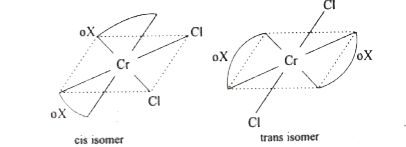Out of the following two coordination entities which is optically active ?
(i) cis[CrCl3(oX)2]−3 (ii)trans [CrCl2(oX)2]−3
The two entities are represented as follows:

of these cis form is optically active.
Topper's Solved these Questions
- BOOK - PREMIERS PUBLISHERSCHAPTER - CO-ORDINATION CHEMISTRY EXERCISE - Other Important Question & Answer (Choose the correct Answer)30videos
CO-ORDINATION CHEMISTRY
- BOOK - PREMIERS PUBLISHERSCHAPTER - CHEMISTRY IN EVERYDAY LIFEEXERCISE - OTHER IMPORTANT QUESTIONS& ANSWERS (ANSWER THE FOLLOWING QUESTIONS)63videos
CHEMISTRY IN EVERYDAY LIFE
- BOOK - PREMIERS PUBLISHERSCHAPTER - ELECTRO CHEMISTRYEXERCISE - OTHER IMPORTANT QUESTIONS & ANSWERS (II. Answer the following questions: )58videos
ELECTRO CHEMISTRY
Similar Questions
Knowledge Check
- Question 1 - Select One
Out of the following coordination entities which is chiral (optically active)
A[Cr(H2O)6]3+Btrans [CrCl2(OX)2]3+Ccis - [CrCl2(NH3)4]+Dcis - [CrCl2(OX)2]3− - Question 2 - Select One
Which of the following will show optical isomers?
(I) cis-[Co(NH3)2(en)2]3+
(II) trans-[IrCl2(C2O4)2]3−
(III) [Rh(en)3]3+
(IV) cis-[IR(H2O)3Cl3]AI, III only correctBII, IV only correctCI, III, IV only correctDIII only correct - Question 3 - Select One
Which of the following will show optical isomers?
(I) cis-[Co(NH3)2(en)2]3+
(II) trans-[IrCl2(C2O4)2]3−
(III) [Rh(en)3]3+
(IV) cis-[IR(H2O)3Cl3]AI, III only correctBII, IV only correctCI, III, IV only correctDIII only correct
Out of the following two coordination entities Which is chiral (optically active)
(a) cis−[CrCI2(OX)2]3−
(b) trans−[CrCI2(OX)2)]3− .View SolutionWhich of the following will show optical isomers?
(I) cis-[Co(NH3)2(en)2]3+
(II) trans-[IrCl2(C2O4)2]3−
(III) [Rh(en)3]3+
(IV) cis-[IR(H2O)3Cl3]View SolutionWhich of the following will show optical isomers?
(I) cis-[Co(NH3)2(en)2]3+
(II) trans-[IrCl2(C2O4)2]3−
(III) [Rh(en)3]3+
(IV) cis-[IR(H2O)3Cl3]View SolutionHow many of the following complexes are optically inactive?
(i) trans-[Co(NH3)4I2]+
(ii) cis-[Co(NH3)2(en)2]3+
(iii) trans-[Co(NH3)2(en)2]3+View SolutionTotal number of complexes among the following which are opticaly active?
(i) [Cr(Ox)3]3−
(ii) cis-[Pt(Cl2)(en)]
(iii) cis[Rh(Cl2)(NH3)4]+
(iv) Ru(dipy)3]3+
(v) cis[Co(NO2)3(dien)]
(vi) Trans-[Co(NO2)3(dien)]
(vii) cis[Co(NO2)3(NH3)3]View Solution

